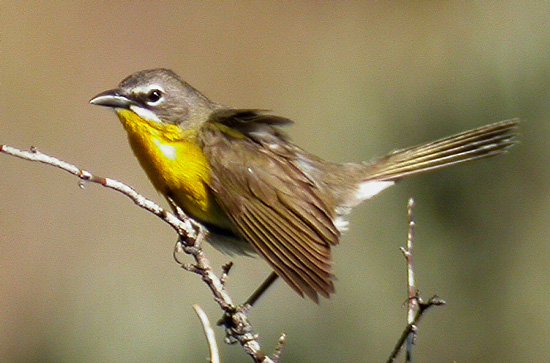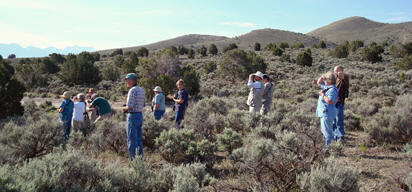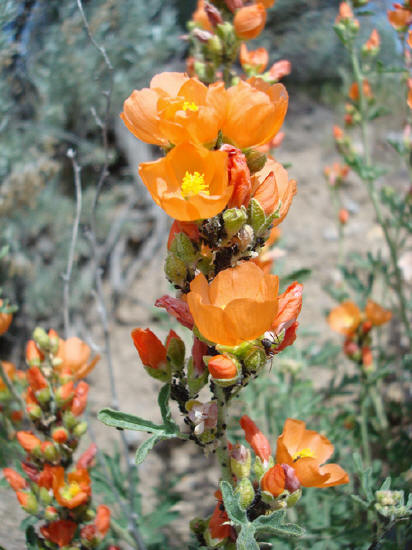Utah County Birders Newsletter
|
|
Dates
|
location
|
departure place and time
|
| Aug. 11 | Uintah Mountains North Slope road | day trip; details TBA |
| August | UOS conference; date and location pending | |
| September | Kennecott's Island Sea preserve with Ann Neville | day trip; date and details TBA |
| September | Brown's Park National Wildlife Refuge, NE Utah | overnight stay in Vernal |
| Oct. 13 & 14 | Zion's National Park | details TBA |
| Nov. 3 & 4 | Moab and Canyonlands National Park | details TBA |
| December | local Christmas bird counts, Provo CBC | details TBA |
Merrill's Musings
By Merrill Webb
Birding in the Tropics
Trinidad Piping-Guan? Never heard of it. Blue-crowned Motmot, Bearded Bellbird,
Golden-headed Manakin? Not in my fieldguide, you say. That is, unless you have
one for Central or South America. These are birds I saw while attending a
Neotropical Bird Ecology workshop at the Asa Wright Centre from May 23-29
sponsored by the American Birding Association's Institute for Field Ornithology.
During the six day workshop which included fieldtrips and study sessions I
observed 120 species, 95 of which I had never seen before. It took me many years
of birding to see five species of tanagers in the United States. I saw that many
the first morning in the tropics, and all of them were new to me: White-lined,
Silver-beaked, Blue gray, Bay-headed and Palm. But I won't bore you by listing
the names of all the birds I saw--many of you have probably never heard of them,
or for that matter, care to. So, I will share some of the things I learned about
tropical birds, especially in comparison with the birds of temperate climates.
The course was taught by Dr. John Kricher, professor of biology at Wheaton
College in Massachusetts and the author of the text we used: A Neotropical
Companion, which is an incredible accretion of facts, figures, and anecdotes
about the biology of tropical organisms. If you plan on going to the tropics you
should probably have this book along with you--or better still, read it before
going. Listed below are a few of the things I learned:
1. There is an incredible number and diversity of birds in the tropics. For
example, at the Explorer's Inn Reserve in southern Peru, about 575 birds have
been identified within an area of about 13,585 acres. By comparison, barely 700
bird species occur in all of North America. The reason so many bird species
exist in the Neotropics is due largely to the unique characteristics provided by
the rainforest environment.
2. Tropical forests offer birds certain resources found in no other ecosystem,
at least not to the same degree of abundance or constancy. According to Dr.
Kricher some of these additional resources are vines, epiphytes, and dry leaf
clusters, all of which add both space and potential food for birds, large
insects, and other arthropods, and the year-round availability of nectar and
fruit. Army ants are a unique resource in that their activity provides the basis
for the existence of "Professional antbirds," species that exclusively follow
army ant swarms feeding on the arthropods driven out by the ants. I witnessed
just such an event during one of our fieldtrips.
3. Dr. Kricher states that, "mild seasonality and consequent predictability of
resources are widely believed to contribute to the high degree of specialization
exhibited by tropical species. In the tropics, species can afford to evolve as
specialists because resources vary less dramatically with the seasons because
something is always flowering, something is always fruiting. The fact that the
tropcis are frost-free could be a major factor responsible for the higher
diversity.
Productivity may be the second resource of most importance. The extraordinarily
high levels of carbon fixation (photosynthesis) that occur in tropical
ecosystems provide a food base that substantially exceeds that in most other
ecosystems. Without so much available organic matter, it is difficult to see how
so many life forms could be sustained."
4. One of the most diverse families of birds in the world is the tyrant
flycatchers (family Tyrannidae), and collectively they provide another excellent
example of the evolutionary process called adaptive radiation. There are 90
genera and an amazing 393 species of tyrannids, all of which are confined to the
New World and most of which are in Central and South America. It has been
estimated that about one of every ten bird species in South America is a tyrant
flycatcher. While most of these are insectivorous some have diverged entirely
from capturing insects to becoming fruit eaters.
One seasonal and dramatic switch is seen with the Eastern Kingbird which, we all
know from watching it on the Provo Airport dike, feeds on insects during the
summer. When on its wintering ground in the tropics, however, it forms large
flocks and feeds mostly on fruit.
5. I thought grouse were the only species of birds that were associated with
leks. Not so. The White-bearded Manakin, a small 4.5 inch long bird which occurs
in most South american countries, is a lek species. The males spend much of
their time displaying at communal display grounds. Display goes on all day, with
peak periods soon after dawn. Each male clears a "court" on the forest floor,
1-2 feet square, and displays on the small saplings bordering it; the court is a
patch of bare earth with all leaves and small twigs removed. The various display
movements include leaping from one perch to another with a loud wing-snap,
leaping from a perch to the ground and back again, fanning the wings, and
sliding head foremost down a vertical sapling. All these movements are extremely
rapid and most are accompanied by stereotyped mechanical sounds made by the
wings. What I found interesting is that breeding has been recorded from December
to September for members of this species. They take three months off during the
molt. This length of reproductive time is not unique to manakins--many of the
tropical bird species can reproduce during eight or nine months of the year and
produce 4-5 clutches per year. This is due to favorable climate and the fact
that there is almost always plenty of available food. 6. We are familiar with
the term "nest site fidelity" where an individual bird will return to the same
area year after year to nest. The American Redstart that we travel up to see at
the Jordanelle wetlands north of Heber has been the same bird. This is based on
the fact that it was trapped and banded and has come back each of the last four
years to the same site. What I didn't realize is that many of these neotropical
migrants also have "winter site fidelity". Many North American migrants that
travel back to the tropics for the winter arrive at the same place year after
year. This is based on banding studies.
As we were sitting in the Port-of-Spain airport waiting for our flight back home
one of the workshop participants asked me if I would come back here again. The
question surprised me. After thinking about an answer for a couple of seconds I
responded, "Nope, not again." It surprised him. But my answer wasn't based on
disappointment or dissatisfaction with what I had seen or what I had learned.
Far from it. As the saying goes, "been there--done that". But that doesn't apply
to the rest of the neotropics. Bring on Belize, or Panama, or Costa Rica, or
Brazil, or Peru. So long Trinidad.
 |
|
photo by Milt Moody |
"The Misfit
Yellow-breasted Chat"
Submitted by Milt
Moody
The Yellow-breasted Chat is a bird, looking to fit in, but can’t quite find a
place where it feels comfortable. Or actually I should say the scientists can’t
figure out a place where this unusual bird fits. They’ve decided to put it with
the warblers, but somehow that doesn’t quite seem right.
It looks like an extra large warbler but has the thick curved bill more like a
tanager and a white-spectacled face more like a vireo. We could call it a
tanager but its long tail and black-white-yellow face isn’t like a tanager at
all not to mention its tendency to skulk in stream-side thickets rather than
high in the leafy tree tops that tanagers like so much.
As a singer – well, its bizarre clucks, rattles, scolds, whistles and mews which
is typically repeated 3 to 8 times – sounds more like a mockingbird, but kind of
a slooooow mockingbird. And like a mockingbird but UNLIKE a warbler it sometime
sings at night and even sometimes during a parachuting flight display –doesn’t
sound much like a warbler OR a vireo either, for that matter. Besides that, have
you ever seen a warbler scratches under its wings or hold food in its feet? I
didn’t think so! They call it a warbler, but I’m not buying it.
Hey, they’ve tried to group it with manakins, vireos, yellowthroats, tanagers,
"honeycreepers," and neotropical chats among other things. I’m thinking maybe
they ought to put it in its own family like the Osprey and let it do its own
thing in peace, instead of trying to fit it into where it doesn’t belong.
This is a pretty unique bird and we here in Utah live in a good place enjoy its
entertaining song and striking good looks during the spring and summer months.
The Yellow-breasted Chat nests mainly in the continental United State and
northern Mexico with a few making their way in to some parts of southern Canada.
In the winter when it’s not around here it likes to live on the edge, so to
speak – it like the edges between the forest and clearings in the lowlands of
Pacific and Atlantic slopes of Mexico (below 5000 feet) and as far south as
western Panama, but THIS is where it chooses to settle down and raise a family –
here in the good ole US of A (well, and northern Mexico and ah, ya, also a
little of southern Canada). Well, they’re definitely all-American birds, anyway,
I’d say.
And if you’re talking about a gender neutral type of bird (which is a big thing
these days), this is a pretty good one. Sex, age and seasonal variations are
quite minor. Yes, there are differences in bill color (blacker in males, with a
little yellow or pink in females and juveniles) and a little brown/gray
variation to the gray in the head and upper parts, but not much. That may be
why, come spring time, the males tend to show off the black lining of their
mouths to females who have pinkish lining who are apparently quite impressed –
viva la difference!
Although they lay 3-5 whitish eggs speckled with reddish browns and gray, in the
nest cups of grass and dead leaves 3-6 feet off ground in a thicket or dense
bush which are vulnerable to the nest the parasitic Brown-headed Cowbird, they
can sometimes distinguish cowbird eggs and destroy them or abandon the
parasitized nests altogether. (Their homeland security is not perfect, but it’s
better than a lot of ‘em). While they’re nesting and raise their young they like
to eat a lot of insects (high protein diet) but when the fruit and berries
mature in late summer they go more for the high-carb diet probably to prepare
for migration. They’re pretty smart birds.
I’ve decided that our unique Yellow-breasted Chat is the comedian of our spring
birds and I’m putting it in the family comediadae. Its entertaining "medley of
strange sounds" raising from the trickling stream makes me chuckle to myself and
smile a little bit and brightens up my day. It’s just being itself – a little
strange, a little different, but all in all, it’s a pretty cool little bird.
---------------------
[ The Bird of the Month is a new monthly column in our
newsletter. We will ask a club member (that’s you) to write about a bird each
month. Tuula Rose has agreed to coordinate the Bird of the Month column. If you
have a bird you want to write about let Tuula know before your bird is taken by
someone else. ]
 |
|
Utah County Birders on Chimney Rock
Road - 12 May 2007
|
 |
|
Globe Mallow -
12 May 2007
|
Field Trip Report
"The Tintics" - 12 May 2007
by Milt Moody
Early on Saturday morning, May 12th, fourteen Utah County Birders lead by Eric "Hawkeye" (and owl-ear) Huish headed out to the Pinyon Juniper habitat of the Tintic Mountains west of Utah Lake.
Before turning off on the Chimney Rock Road, we saw a Burrowing Owl on a mound at about mile post 1 (a traditional spot) along SR 68, north of Elberta. There were also several Swainson's Hawks, a Long-billed Curlew and some Prong-horned Antelope along the paved road, but we couldn’t linger to check out the abundant bird activity of our "normal" birding areas -- our destination was the pinyon-juniper passes of the Tintic Mountains.
We caravanned along the unpaved Chimney Rock Road making our first stop just beyond the monumental "Chimney Rock", a prominent and obvious landmark . There we saw several Black-throated Sparrows at close range, bunches of Lark Sparrows, a Northern Mockingbird that had been chattering from over the hill and a Nashville Warbler that Ned Bixler had chased down in the bushes of the sagebrush slope. As we entered Cedar Valley and turned south going toward Homansville Pass, we saw some Horned Larks in the open fields, and Turkey Vultures gliding over the ever more densely treed pass ahead. In the pass we saw a Gray Flycatcher and some newly arriving Bullock’s Orioles, along with some other less note-worthy (but still interesting) birds.
As we came to Highway 6, we turned west and drove into the once prosperous town of Eureka nestled in the mine-pocked Tintic slopes for a rest stop and for some a chance to check out an old Porter Rockwell cabin in "mid-town" Eureka. We continued our birding adventure by taking the familiar "Dividend Loop" road from a different direction and came across an always fun-to-see Green-tailed Towhee, a few regulars including an un-identifiable empidonax flycatcher and a newly-arrived male Black-headed Grosbeak to wind up the tour. We saw about 38 species on the blossoming pinyon-juniper slopes and had a great time on a magical spring morning.
 |
|
At Vivian Park watching White-throated
Swifts - 26 May
2007 |
Field
Trip Report
Big Day - 26 May 2007
by Dennis Shirley
I think this year was the seventh year we've held an annual Utah County Big Day
either in conjunction with the Great Salt Lake Bird Festival or like this year
on a separate day. This year our "Big Day" was on saturday May 26th. There were
21 participants in five cars, a much more workable group than 43 people and 17
cars like on the GSLBF trip on the 22nd.
Our trip total of 124 species is I think the most we have ever got as a trip list. Most of the group saw over a hundred species, and several participants from SLC Birders were using the days total to help meet their 2007 club challenge of either 207 state birds or 107 in a county. I think the most any one person was 116 or 117.
We traveled to the usual spots [ Utah Lake, Provo Canyon, Goshen areas, Tintics] but ran out of daylight before Payson Canyon. With a little better plans we chould have got into the 130's. Maybe next year!
No real rarities were found, but we got most of the target species at each
location. Our list included 12 waterfowl, 9 shorebirds, 8 icterids[blackbird
types], 8 birds of prey, 7 sparrows, 6 warblers, 5 herons, 4 jays/crows, 3
pigeon/doves, 2 hummers, and a partridge [quail] in a tree.
Backyard Bird of the
Month
May 2007
Steve Carr - Holladay
Red-breasted Nuthatch - Unusual sighting in my yard for May.
Eric Huish - Pleasant Grove
Western Kingbird - I've seen one once before but now there is a pair
hanging around.
Milt Moody - Provo
Bullock's Oriole - 1st year male at the hummingbird feeders.
LeIla Ogden - Orem
Two ravens at my cabin above midway were frantically pecking, flapping,
and scratching at the glass door of the cabin like they were trying to get in.
Tried it a second time an hour later.
Cheryl Peterson - Provo
The 4 Black-chinned Hummingbirds that have been coming to my feeders have
been so fun to watch.
Bruce Robinson - West Jordan
California Quail - Third year in a row!!!!
Tuula Rose - Provo
Young starlings just fledged out of my owl box and the cowbirds
are scarfing up sunflower seeds - drats!
Reed Stone - Provo
Cedar Waxwing - flycatching, beautiful.
Bonnie Williams - Mapleton
Virginia's Warbler - Stopped for a short visit.
We would like you to share your favorite backyard bird each
month. Please send your favorite bird at the end of the month to
newsletter@utahbirds.org or call 360-8777. If you would like a reminder at
the end of the month e-mail the above address.